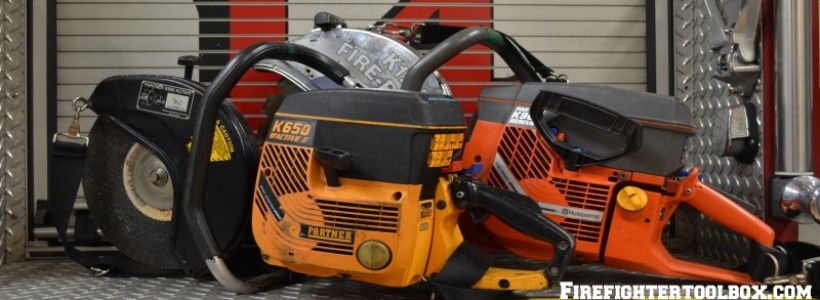4 Steps To Simple Saw Maintenance
Maintaining our equipment so it performs safely and effectively as well as reliably is one our most important jobs. There is simply no excuse for taking a saw off the rig when needed and discovering that you cannot get it started or that the blade needed to be replaced from previous use and was not.
Some of the work included in properly maintaining your saw may require you to use the services of your department or district mechanic or repair shop but the simple steps below can be taken care of by a firefighter in house.
#1 – Fuel Mix
A two-cycle motor requires a fuel and two-cycle oil mix. If you run straight gas in a two-cycle motor prepare yourself for an impending disaster.
That being said, we must also keep in mind that the fuel/oil mix must be in the correct ratio for the particular manufacturer of saw that we are using. Some common ratios are 32:1, 40:1 and 50:1. The gas can you use to store your mix in should also be clearly labeled as to what is inside. Or, label it with the name of the particular saw that it is to be used for. It is also helpful to label the saw itself somewhere with what mixture is appropriate for that particular saw.
When fueling your saw, give the can a good shake before pouring gas into the saw. Over time, oil and gasoline can separate. Giving it a good shake prior to refueling will ensure a proper mixture makes it into the tank.
Gas does go bad after a period of time and has the potential to make the saw not start or run poorly. There are several commercially available fuel stabilizers that do a good job extending the life of the fuel. Many two-cycle oils come with the stabilizer added already as well.
Fuel should also not sit in your saw for a particularly long time. Use it!
#2 – Cleaning
Our equipment should be kept clean and the saw is no exception. What your equipment looks like is a direct reflection on you, your company and your department. Clean any debris off the saw that has the potential for getting stuck in the blade. Roofing material is a particular concern and should be cleaned off immediately after use, before the saw is put back into service.
#3 – Blades
The blade is the business end of the saw. If you are using it for wood, make sure the carbide tips are in good condition and none are missing. If you are cutting metal or concrete make sure your blade is the correct diameter (i.e, not worn down to nothing). Your department should have guidelines to determine when it is necessary to change out the blade.
#4 – Start The Saw Regularly
At the beginning of every shift for a career department or on a weekly basis (preferably more often) for a volunteer department, the saw should be started and brought up to operating temperature.
Start the saw, rev it up and let it come back down to idle. It may take thirty seconds or so before the saw will operate and full throttle for a period of time. Run the saw wide open for a minute or so, let it come back down to idle and do it again.
Do not let the saw idle for extended periods of time. This can cause excess oil to build up in the combustion chamber and has the potential to foul the plug, causing a saw that will be difficult to start and has the potential to operate poorly. If for some reason the saw does idle for a period of time, before shutting it down, operate it at full throttle to “blow it out” and then shut if off.
Whether your power saw is used for ventilation, forcible entry or other type of task, a saw that is well taken care of (just like any other tool on our apparatus) will take care of you. If you have any maintenance or use tips please feel free to leave them in the comment section.
Photo courtesy of Courtney Fling
See these other articles:







Couple of things to understand about the fuel. Good clean gas means No ethanol. Gasoline has a shelf life of about a year, but gas with 10% ethanol can and will gel depending on temps (faster if colder) As in only last a couple months. Best idea, only use straight gas.